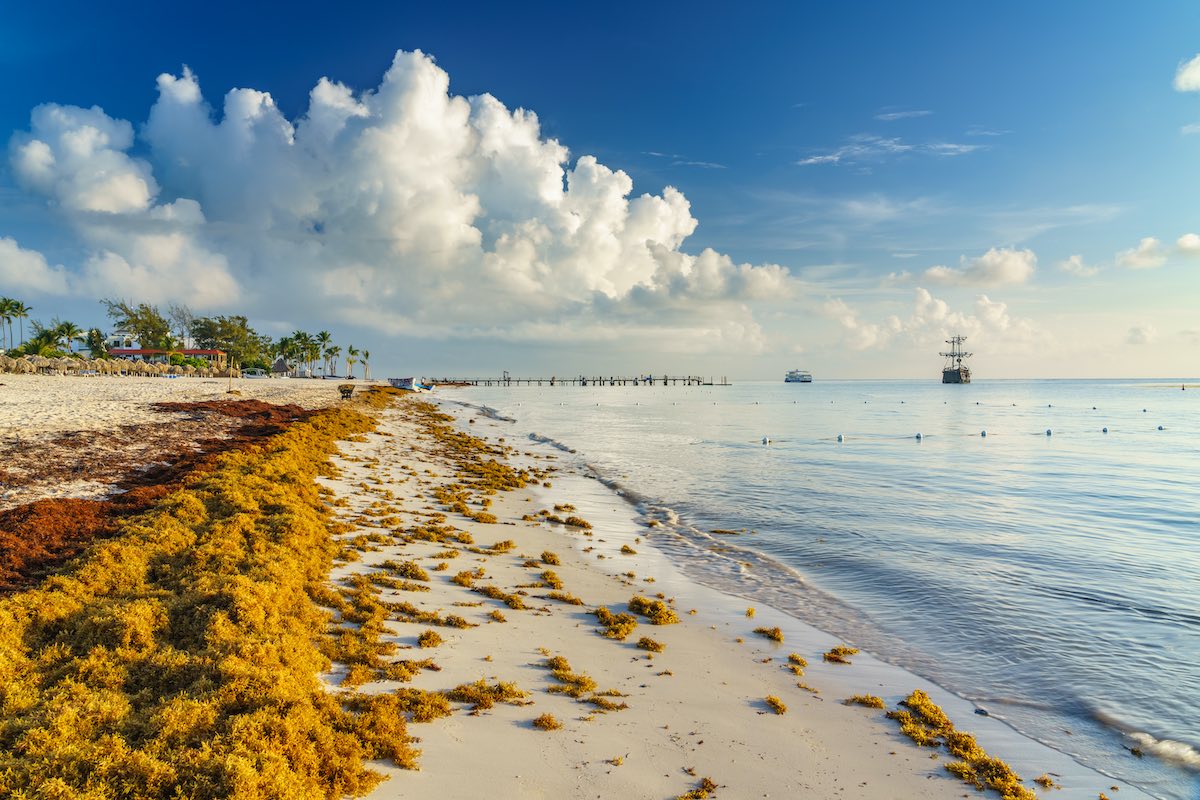Last Updated
Imagine flying to your favorite holiday spot and suddenly feeling your feet caught in the grass while walking on the beach. When you glance down, there it was… seaweed. Tourists in these areas are also experiencing this, as masses of sargassum seaweed have invaded popular tourist destinations in the Caribbean.
From Puerto Rico to Barbados—for months, disrupting vacations and caused concern among local officials about financial and environmental consequences.
“This has been the worst year on record,” said Lisa Krimsky, a researcher and school member with Florida Sea Grant, according to the news agency Associated Press (AP).

Over 18.8 million tons in May and over 24 million tons this year of these brown algae spread over the Atlantic Ocean, and by July officials knew that the sargassum kept arriving and quantities had not diminished.
[WooZoneProducts asin=”amz-B09JT1W9T8″][/WooZoneProducts]In a recent publication, the University of South Florida’s Optical Oceanography Lab referred to this year’s figures as “a new historical record.”

According to Chuanmin Hu, an oceanography expert, the previous file was made public in May 2018, and this year’s sargassum levels had increased by 20%. The lecturer admitted his reaction: “I was afraid.”
In June, about 800 tons of sargassum were harvested alone from the beaches of Cancun. Different administrations in the Caribbean have dealt with this issue in various ways, utilizing various approaches to protect natural wildlife and prevent tourism turmoil.
What Travelers Should Know About Sargassum

Some people have experienced rashes and blisters after coming into contact with this seaweed. According to the Florida Health study, this is caused by sea organisms that live inside the algae. As a result, it is recommended to avoid contact with it.
The sargassum creates island-like lots within the ocean that assist animals to migrate and has an essential position in our ecosystem, but it surely provides hydrogen sulfide that may irritate the eyes, throat, and nostrils. Travelers with bronchial asthma or different respiratory diseases could be extra affected or might have hassle respiratory after being uncovered to it.
[WooZoneProducts asin=”amz-B07H39MBTC”][/WooZoneProducts]These are common suggestions when visiting a seashore with sargassum:
- Do not touch it.
- If you must deal with it, use gloves.
- Keep doors and windows closed if you’re staying near sargassum-infested beaches or coastlines.
- If you have bronchial asthma or respiratory problems, avoid going to the beach or remaining for too long.
- Do not prepare or consume it. It should not be consumed since it may contain heavy metals such as arsenic and cadmium.

Another option for visitors is to arrange their Caribbean vacations around times when they may avoid the algae or choose locations where it does not generally reside.
The best months to visit the Caribbean are between November and March, whereas the peak season for sargassum is usually between May and September.
Top Destinations Dealing With Sargassum

Cancun officials have ordered native workers to collect sargassum and transport it to seashores. Travelers have chosen to visit seashores and regions that do not have these algae, such as Isla Mujeres, or to see magnificent Cenotes around Quintana Roo.
Local officials in Puerto Rico are concerned about sargassum because they believe it will influence one of the island’s most popular destinations, the bioluminescent bay Fajardo. Tourism kayak companies and the federal government are researching sargassum and working on solutions to remove it from their shores.

International agencies, including the United Nations, are studying the sargassum, seeking to figure out why it keeps growing and negotiating the best solutions.
Moreover, several native corporations are incorporating sargassum into new goods ranging from gasoline to beauty items to vegan leather-based to make use of its surplus and transform it into current possibilities.
Read More:
3 Popular Beaches In Mexico Considered Unsafe For Swimming Due To Bacteria
Travel Insurance That Covers Covid-19 For 2022
Digital Nomad Scene In Mexico City Exploding In Popularity
↓ Join the neighborhood ↓
The Travel Off Path Community FB group has all the newest reopening information, conversations, and Q&A’s occurring each day!

SUBSCRIBE TO OUR LATEST POSTS
Enter your electronic mail handle to subscribe to Travel Off Path’s newest breaking journey information, straight to your inbox
Disclaimer: Current journey guidelines and restrictions can change with out discover. The determination to journey is in the end your duty. Contact your consulate and/or native authorities to substantiate your nationality’s entry and/or any adjustments to journey necessities earlier than touring. Travel Off Path doesn’t endorse touring in opposition to authorities advisories





